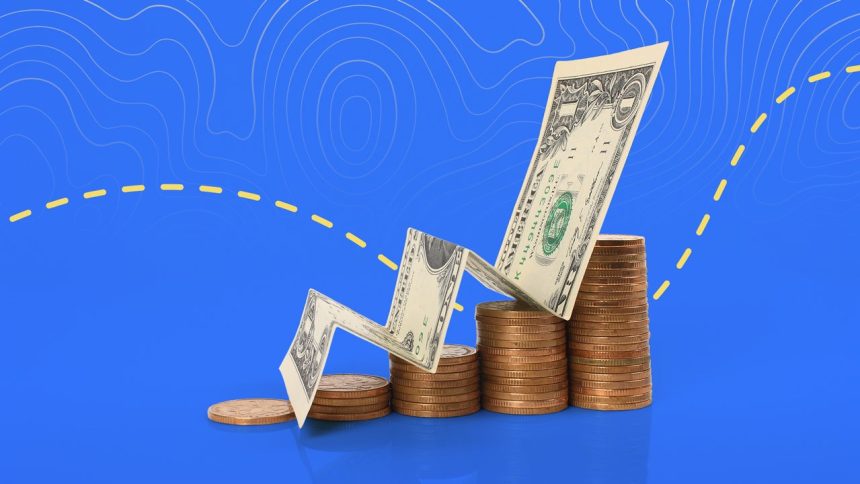LUHUANFENG/Getty Images; Illustration by Bankrate
Key takeaways
- A CD ladder entails opening multiple CDs with varying terms and maturity dates.
- CD ladders allow you to take advantage of potentially higher yields, while also maintaining some liquidity.
- Once a CD in your ladder matures, you can choose to open another CD or invest that money elsewhere.
A CD ladder is a savings strategy where you invest in multiple certificates of deposit (CDs) with staggered maturity dates. When a given CD in your ladder matures, you could devote the money to a new CD, invest it elsewhere or use it for a planned purchase.
How to build a CD ladder
To build a CD ladder, you’ll open multiple CDs, staggering term lengths. Keep in mind these don’t need to be opened at the same bank or credit union. The number of CDs you open, the amount you deposit and the length of terms are up to you, but here’s an example of how it could work.
Let’s say you want to build a five-year CD ladder with five rungs. If you have $2,500 to invest, then you might divide the funds equally into five CDs with different maturity dates. Here’s how you could set it up:
1. Open the CDs.
In this example, you’ll open five CDs with terms ranging from one year to five years as follows:
2. Reinvest the money when the CDs mature.
When each of the original CDs matures, you could continue to build your ladder by reinvesting the funds (principal and interest) in a new five-year CD. This will continue to give you a ladder of five CDs, with one maturing each year:
- $500 (original CD principal) + one year of interest in a five-year CD
- $500 (original CD principal) + two years of interest in a five-year CD
- $500 (original CD principal) + three years of interest in a five-year CD
- $500 (original CD principal) + four years of interest in a five-year CD
- $500 (original CD principal) + four years of interest in a five-year CD
You can continue the process each year for as long as you want to maintain the CD ladder. Depending on your financial needs and goals, you can also choose to cash out the CDs and use the money for other purposes or investments.
No matter what CD term lengths you’re investing or reinvesting in, just remember that there’s usually an early withdrawal penalty for taking out the funds before the CD’s maturity date (though you can find no-penalty CDs if you’re worried about liquidity).
When it comes to maximizing your earnings from an ongoing CD ladder, it pays to shop around for the best annual percentage yield (APY) when any CD in your ladder is set to mature, says Karen Bennett, senior consumer banking reporter at Bankrate. “If you simply renew a given CD, or open a new one at the same bank by default, you could be missing out on significantly higher rates available elsewhere. Ultimately, there’s no obligation to keep all your CDs at the same bank.”
Alternative CD ladder structures
There are several ways to modify a traditional CD ladder strategy based on your goals:
- Mini CD ladder: Creating a CD ladder with only shorter-term CDs could be an option for savers who don’t wish to invest in longer-term ones. For instance, such a ladder could consist of terms of six, nine, 12 and 18 months.
- Barbell CD ladder: A barbell CD strategy is similar to a traditional CD ladder, but the middle rungs are missing. As such, short-term CDs make up one end of the structure, while long-term CDs comprise the other end. A potential benefit of this is you could have access to some of your funds sooner, while taking advantage of longer terms with potentially higher rates, if available.
- Bullet CD ladder: A bullet CD strategy consists of opening several CDs over time, of varying term lengths, that will all mature at once. An example would be opening a five-year CD now, a four-year CD in a year and a three-year CD in two years. This can come in handy when you’re planning for a large expense. You won’t have to come up with all of the funds at once, giving you time to save more money to commit to additional CDs.
Benefits of a CD ladder
- If you open a CD at a Federal Deposit Insurance Corp. (FDIC)-insured bank or a share certificate at a National Credit Union Administration (NCUA)-insured credit union, your money is protected up to $250,000 per depositor, per institution and per ownership category.
- As with all fixed-rate CDs, there is a guaranteed rate of return.
- You can take advantage of higher rates on shorter-term CDs while having some funds earn predictable rates for longer terms.
- If rates rise, you can reinvest the money from shorter-term CDs into new accounts to lock in higher APYs.
- Keeping some funds in shorter-term CDs ensures that your money is more accessible than if it were all kept in a long-term CD.
A benefit of a CD ladder is it can help you earn a guaranteed, competitive APY while freeing up portions of your money periodically, Bankrate’s Bennett says. “Once a CD from your ladder matures and the money becomes available again, you can re-invest it in a new high-yield CD or use it for other purposes.”
Drawbacks of a CD ladder
- You could be missing out on higher returns from more aggressive investments, such as stocks or bonds.
- If interest rates decline, you might be reinvesting the money from a matured CD into an account with lower rates.
- With investing in CDs and CD ladders, you need to keep track of maturity dates. If you miss a date, a CD may get automatically reinvested in a CD at a term or APY you weren’t planning on and aren’t happy with.
- If you invest too much in longer-term CDs, you may find yourself having to withdraw money before the maturity date and get hit with a penalty fee.
- Even if you have shorter-term CDs that will give you access to your money sooner, your money is still locked up. If you end up needing the money before the maturity date, you will likely an early withdrawal penalty to face.
Are CD ladders good investments?
To determine if CD ladders are a good investment for you, consider your personal situation and goals.
If you’re most interested in fixed, guaranteed returns, a CD ladder might be a good fit. This allows you to know exactly how much your CDs will earn. While rates can vary, currently the best CD rates are above 4 percent APY.
While you may be able to earn more on other investments, such as retirement accounts, those returns aren’t guaranteed. Plus, choosing a CD with a federally insured institution can protect your money within the specific limits.
You might also find a CD ladder is right for you if you’re confident you won’t need your money in the timeframe of your CD terms, which could be anywhere from three months to ten years. If you need access to your funds before the CD matures, you will likely pay an early withdrawal fee. For this reason, a high-yield savings account is a better option for your emergency fund.
Bottom Line
As with all federally insured CDs, a CD ladder could be a low-risk investment for your money. Staggering various maturity dates with multiple CDs may allow you to have a little more control over your money while still taking advantage of guaranteed returns.
Read the full article here














